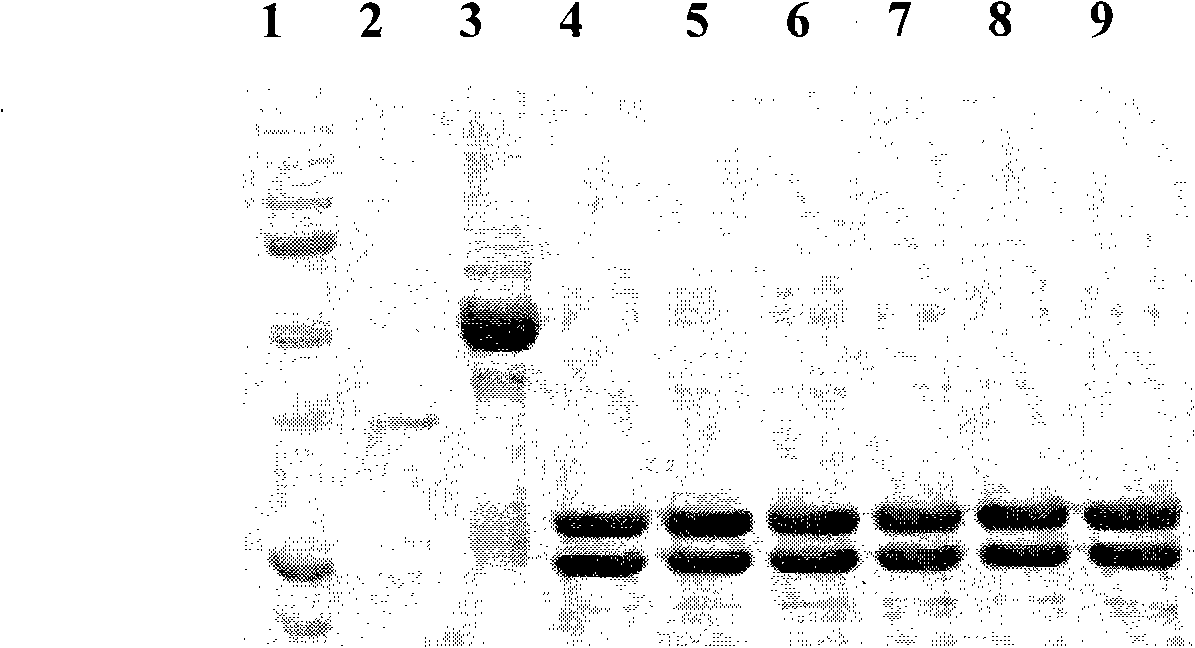Antihuman SCGN monoclone antibody, preparation, application and hybrid tumor cell strain
A monoclonal antibody and recombinant protein technology, applied in the direction of anti-animal/human immunoglobulin, anti-hormone immunoglobulin, biochemical equipment and methods, etc., can solve diagnostic difficulties, small cell lung cancer does not express neuroendocrine markers, etc. problem, to achieve the effect of significant application prospects
- Summary
- Abstract
- Description
- Claims
- Application Information
AI Technical Summary
Problems solved by technology
Method used
Image
Examples
Embodiment 1
[0031] Embodiment 1: Expression and purification of GST-SCGN fusion protein
[0032] 1. Induced expression of GST-SCGN fusion protein
[0033] A. Pick the pGEX-4T-1 / SCGN plasmid (constructed by Shanghai Yuhua Life Science and Technology Development Co., Ltd.) containing the nucleotide sequence shown in SEQ ID No.3 to the LB culture medium (containing Amp50 μg / ml) overnight at 37°C.
[0034] B. Dilute the overnight bacteria at a ratio of 1:100, and culture with shaking at 37°C until the OD600 of the bacterial solution reaches 0.4-1.0.
[0035] C. Add IPTG inducer to a final concentration of 1 mM, and induce for 4 hours at 30°C.
[0036] D. Centrifuge at 4500rpm for 5 minutes, collect the cells and suspend them in pre-cooled PBS (Phosphate Buffer Solution) phosphate buffer solution, add phenylmethylsulfonamide fluoride (PMSF) to a final concentration of 2 mmol / L.
[0037] E. Sonicate the bacterial cells in an ice bath (5 seconds each time, 5 seconds in between, 30 minutes in...
Embodiment 2
[0060] Embodiment 2: the preparation of antiserum
[0061] Use 50 μg of purified SCGN protein and an equal volume of complete Freund's adjuvant to fully mix and emulsify it, and the formation of water-in-oil is a sign of successful mixing. Female BALB / c mice aged 6-8 weeks were injected subcutaneously at multiple points on the back for primary immunization. Two weeks later, BALB / c mice were boosted with an equal volume of incomplete Freund's adjuvant and 50 mg of SCGN protein emulsified, and boosted every two weeks thereafter. After boosting immunization for 3 times, blood was collected from the eyes of the mice and the serum was separated, and the titer was determined by indirect ELISA method. When it reached 10 -4 Then ready to blend. Immunization was boosted once three days before fusion, and immunized mice were obtained.
Embodiment 3
[0062] Embodiment 3: Preparation of monoclonal antibody
[0063] 1. Feeder cell plating
[0064] A 16-week-old BALB / c immunized mouse was killed by pulling its neck, and then disinfected by soaking in 75% alcohol. The peritoneal cavity was opened, feeder cells were taken, plated, cultured in a 37°C incubator, and reserved for the next day.
[0065] 2. Fusion of immunized splenocytes with mouse myeloma cells
[0066] The spleen of the immunized BALB / c mouse was taken under aseptic conditions, the capsule was peeled off to free the cells, and the filtered spleen cells were collected by passing through a 100-mesh steel mesh. Mix SP2 / 0 cells in a good growth state and in the logarithmic growth phase with splenocytes at a ratio of 1:10, fuse with 50% PEG as the mediator, resuspend the cells with HAT medium after centrifugation, and use the containing Spread the HAT culture medium of the cells on a 96-well plate, 2 drops per well. Placed at 37 degrees, 5% CO 2 cultured in an in...
PUM
 Login to View More
Login to View More Abstract
Description
Claims
Application Information
 Login to View More
Login to View More - R&D
- Intellectual Property
- Life Sciences
- Materials
- Tech Scout
- Unparalleled Data Quality
- Higher Quality Content
- 60% Fewer Hallucinations
Browse by: Latest US Patents, China's latest patents, Technical Efficacy Thesaurus, Application Domain, Technology Topic, Popular Technical Reports.
© 2025 PatSnap. All rights reserved.Legal|Privacy policy|Modern Slavery Act Transparency Statement|Sitemap|About US| Contact US: help@patsnap.com



